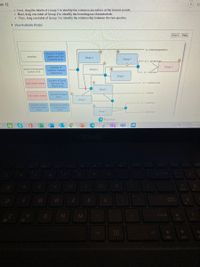
Human Anatomy & Physiology (11th Edition)
11th Edition
ISBN: 9780134580999
Author: Elaine N. Marieb, Katja N. Hoehn
Publisher: PEARSON
expand_more
expand_more
format_list_bulleted
Concept explainers
Question

Transcribed Image Text:em 12
12
• First, drag the labels of Group 1 to identity the common ancestors at the branch points.
• Next, drag one label of Group 2 to identify the homologous characteristic.
• Then, drag one label of Group 3 to identify the relationship between the two species.
> View Available Hint(s)
Reset Help
U. cinereoargenteus
(b)
ancestor of Santa
Catalina and San
Clemente foxes
dwarfism
Group 1
Group 1
U. I. santarosae
Group 3
diploid chromosome
number of 66
ancestor of
southern Channel
Island foxes
Group 2
U. I. littoralis
Group 1
ancestor of Santa
Rosa and San
U. I. santacruzae
least closely related
Miguel foxes
Group 1
U. A. dickeyi
9)
most closely related
ancestor of island
foxes
Group 1
U. I. catalinae
ancestor of gray
foxes and island
ancestor of northern
Channel Island
foxes
foxes
Group 1
U. L. clementae
P Pearson
1207 PM
97/2021
pouse
breok
prt sc
sysra
delete
home pgup pade
8.
backspace
num ik
scr ik
R
Y
U
7
8
home
enter
D
B
shift &
end
lt
ctrl

Transcribed Image Text:Part B- Phylogenetic trees and geographic relationships
The island fox, Urocyon littoralis, is endemic to the Channel Islands, which are located off the coast of southern California, Six of the eight Channel Islands support fox
populations, and each of these islands is home to a distinct subspecies, as shown in the table below.
Island
Subspecies
Santa Cruz
santacruzae
Northern Chanel
Islands
Santa Rosa
U. I. santarosae
San Miguel
U. I. littoralis
San Nicolas
U.I. dickeyi
Southern Channel
Islands
San
Clemente
U.I. clementae
Santa
Catalina
U.I. catalinae
The island fox shares a common ancestor with the gray fox. Urocyon cinerecargenteus, which is found on the mainland. Both species have similar coloration and a
diploid chromosome number of 66. One structural difference between the two species is the reduced size of the island fox, a feature known as dwarfism. The various
island subspecies also differ from each other in size, number of tail vertebrae, and other characteristics
The phylogenetic tree below shows the evolutionary relationships between the island fox subspecies and the gray fox Drag the labels to their appropriate locations on
the tree.
First, drag the labels of Group 1 to identify the common ancestors at the branch points.
• Next, drag one label of Group 2 to identify the homologous characteristic.
• Then, drag one label of Group 3 to identify the relationship between the two species.
PPearson
T
1207 PM
ICister
pouse
prt se
DIR
break
delete
home
pgup
pgdn
sysrg
en
8.
backspace
num Ik
Scr
E
R
T
P
home
dnbd
paup
D F
K
enter
4.
shift
end
alt
ctrl
CH
inser
00
Expert Solution
This question has been solved!
Explore an expertly crafted, step-by-step solution for a thorough understanding of key concepts.
This is a popular solution
Trending nowThis is a popular solution!
Step by stepSolved in 2 steps with 1 images

Knowledge Booster
Learn more about
Need a deep-dive on the concept behind this application? Look no further. Learn more about this topic, biology and related others by exploring similar questions and additional content below.Similar questions
- 18. If you could protect from extinction only the lineages derived from two of the nodes in the figure, which pair would you save to yield the greatest phylogenetic diversity? Mammuthus primigenius Extinct C Elephas maximus A B Elephas maximus B Loxodonta africana A E A Loxodonta africana B Dugong dugon F Procavia capensis a. Nodes E and F b. Nodes D and E c. Nodes C and D d. All of the choices are equivalent.arrow_forwardSpecies Concepts Review The Baltimore Orioles and Black-backed Orioles species complex has conflicting evidence in support of each being their own species and in support of them being the same species. Review the evidence below for each hypothesis, then, using that evidence, explain whether they should be classified as distinct or the same species based on each species concept. Then, using the overall evidence, decide whether to classify them as the same or different species. Genetic Information (In the Species Concepts lab, we used a "controversial" 10% cutoff. A more realistic cutoff might be 1%. Let's use a 1% cutoff for this activity.) Sequence Differences Baltimore Oriole vs Black- backed Oriole Cytochrome b 0.26% Control region 0.74% 2A. Based on the genetic information above, should the Baltimore Oriole and Black-backed Oriole be classified as one species or two species?arrow_forwardSwordtails, platyfish and Poecilia species are incapable of interbreeding with each other but swordtail species 1 can produce viable hybrids with swordtail species 2. In addition, both Poecilla fish, platyfish, and swordtails can all be distinguished genetically, but swortail species 1 and 2 cannot be genetically distinguished. Using this information indicate how many distinct 1) Biological, 2) morphological, and 3) phylogenetic species would be found in this group of fish. If you cannot determine this for any of the 3 species categories, state what you would need to know in order to do so. Edit View Insert Format Tools Table 12pt v Paragraph v BIUAv er Tv: 1. There are four 2.arrow_forward
- determine the outgroup, monophyletic and paraphyletic groups of the phylogenetic tree givenarrow_forwardConstruct a phylogenetic tree with the species and label the traits according to their number (ex. T1, T2, etc.)arrow_forwardSimilar genes in two separate lineages that are the result of a "lineage splitting event" A at some point in their history (see graphic Species divergence are called genes (spelling counts!) – A – A - Further evolution A - A" Species 1 Species 2arrow_forward
- 2. Application Sapiens existed on Earth for a relatively long time? Explain. Yes, 300,000 years in fact Prior to the discovery of A. ramidus, could such a species be considered to be a "missing link"? Explain. 3. How long would a timeline be (in kilometers) using a scale of 10 cm = 1,000 years? on Farth is characterized by the appearance of many new species and the e by the persistence of some forms that garliestarrow_forwardChargaffs DNA Data Base Compoeltion In Varlous Speclee (%) Species A T G Homo sapiens 31.0 31.5 19.1 18.4 Drosophila melanogaster 27.3 27.6 22.5 22.5 Zea mays 25.6 25.3 24.5 24.6 Neurospora crassa 23.0 23.3 27.1 26.6 Escherichia coli 24.6 24.3 25.5 25.6 Bacillus subtilis 28.4 29.0 21.0 21.6 The table above shows the amount of the 4 DNA nucleotides found in 6 different species. Another species has DNA that is 10% Adenine (A). What is the % of T, G, and C in the DNA of this species? You may copy and paste this sentence to help you answer clearly: The species is 10% A, 96 T, 96 G and 96 C. The species is 10% A, 10 % R, DELL F11 PrtScr F4 F5 F6 F7 F8 F9 F10 F12 In & 8. 9. 5 6. 7 9. E T Y *00 %S4arrow_forward8) What data would suggest that a species evolutionary history includes sexual selection as a mechanism that helped shape the species? A) If males and females are significantly different from each other (sexual dimporphism) B) If some males reproduce with multiple females while other males do not reproduce C) If males engage in "risky" behavior D) If males and females form different social groups (i.e. herds are formed from either males or females but not both)arrow_forward
- Among the ingroup species A-D, species A shares the largest number of derived traits with species C. What term best describes species C relative to species A? options: ancestor homologous species outgroup sister speciesarrow_forwardanalyze the phylogenetic tree and report its summary/inference (outgroup, etc)arrow_forward#8arrow_forward
arrow_back_ios
SEE MORE QUESTIONS
arrow_forward_ios
Recommended textbooks for you
 Human Anatomy & Physiology (11th Edition)BiologyISBN:9780134580999Author:Elaine N. Marieb, Katja N. HoehnPublisher:PEARSON
Human Anatomy & Physiology (11th Edition)BiologyISBN:9780134580999Author:Elaine N. Marieb, Katja N. HoehnPublisher:PEARSON Biology 2eBiologyISBN:9781947172517Author:Matthew Douglas, Jung Choi, Mary Ann ClarkPublisher:OpenStax
Biology 2eBiologyISBN:9781947172517Author:Matthew Douglas, Jung Choi, Mary Ann ClarkPublisher:OpenStax Anatomy & PhysiologyBiologyISBN:9781259398629Author:McKinley, Michael P., O'loughlin, Valerie Dean, Bidle, Theresa StouterPublisher:Mcgraw Hill Education,
Anatomy & PhysiologyBiologyISBN:9781259398629Author:McKinley, Michael P., O'loughlin, Valerie Dean, Bidle, Theresa StouterPublisher:Mcgraw Hill Education, Molecular Biology of the Cell (Sixth Edition)BiologyISBN:9780815344322Author:Bruce Alberts, Alexander D. Johnson, Julian Lewis, David Morgan, Martin Raff, Keith Roberts, Peter WalterPublisher:W. W. Norton & Company
Molecular Biology of the Cell (Sixth Edition)BiologyISBN:9780815344322Author:Bruce Alberts, Alexander D. Johnson, Julian Lewis, David Morgan, Martin Raff, Keith Roberts, Peter WalterPublisher:W. W. Norton & Company Laboratory Manual For Human Anatomy & PhysiologyBiologyISBN:9781260159363Author:Martin, Terry R., Prentice-craver, CynthiaPublisher:McGraw-Hill Publishing Co.
Laboratory Manual For Human Anatomy & PhysiologyBiologyISBN:9781260159363Author:Martin, Terry R., Prentice-craver, CynthiaPublisher:McGraw-Hill Publishing Co. Inquiry Into Life (16th Edition)BiologyISBN:9781260231700Author:Sylvia S. Mader, Michael WindelspechtPublisher:McGraw Hill Education
Inquiry Into Life (16th Edition)BiologyISBN:9781260231700Author:Sylvia S. Mader, Michael WindelspechtPublisher:McGraw Hill Education

Human Anatomy & Physiology (11th Edition)
Biology
ISBN:9780134580999
Author:Elaine N. Marieb, Katja N. Hoehn
Publisher:PEARSON

Biology 2e
Biology
ISBN:9781947172517
Author:Matthew Douglas, Jung Choi, Mary Ann Clark
Publisher:OpenStax

Anatomy & Physiology
Biology
ISBN:9781259398629
Author:McKinley, Michael P., O'loughlin, Valerie Dean, Bidle, Theresa Stouter
Publisher:Mcgraw Hill Education,

Molecular Biology of the Cell (Sixth Edition)
Biology
ISBN:9780815344322
Author:Bruce Alberts, Alexander D. Johnson, Julian Lewis, David Morgan, Martin Raff, Keith Roberts, Peter Walter
Publisher:W. W. Norton & Company

Laboratory Manual For Human Anatomy & Physiology
Biology
ISBN:9781260159363
Author:Martin, Terry R., Prentice-craver, Cynthia
Publisher:McGraw-Hill Publishing Co.

Inquiry Into Life (16th Edition)
Biology
ISBN:9781260231700
Author:Sylvia S. Mader, Michael Windelspecht
Publisher:McGraw Hill Education